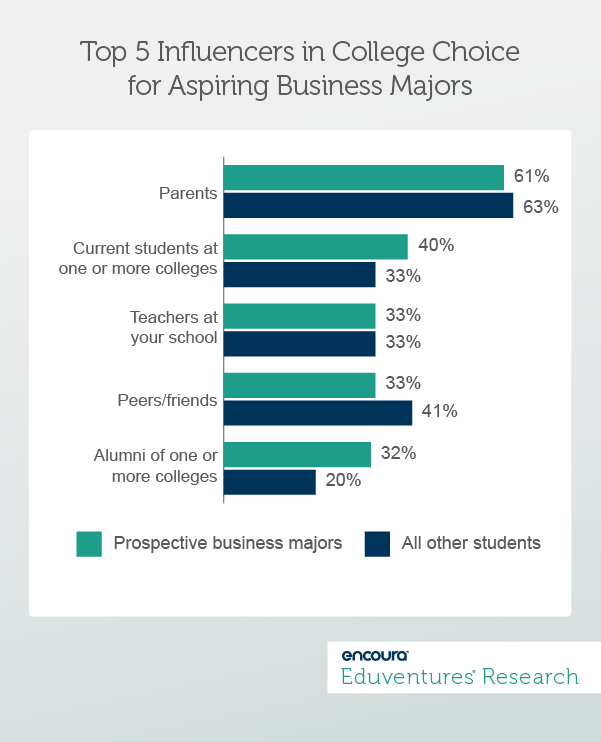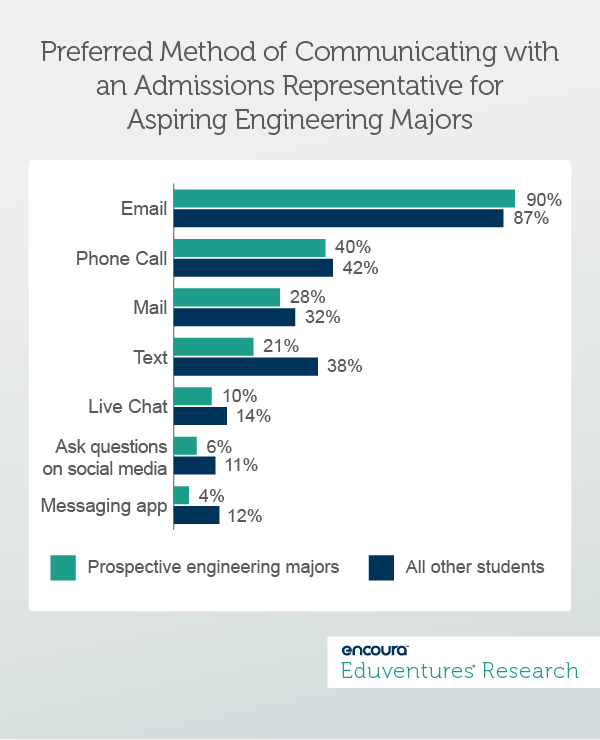Colleges and universities are wise to consider their prospects’ academic and career aspirations. Although many college-bound high school students will change their major during college, their perceptions about the availability and quality of their chosen fields of study rank among the top application and enrollment drivers.
Likewise, many institutions work hard to revise and improve their academic portfolios to continuously attract students. Calibrating the program portfolio to meet demand and personalizing outreach are important recruitment tactics, but we believe that
Finding the Right Channel
It’s critically important to send the right message to the right prospective student. But, how do you know if the message is received? Eduventures research shows that institutions need not only consider the message but also the channel.
To this point, let’s explore a different vantage point for effective programmatic marketing. What do students who are interested in health-related programs have in common? Do they respond differently to institutional marketing efforts than students who plan to major in engineering?
The answer can be found in our 2019 Student Sentiment Survey™, an annual study examining the college search behaviors and communication preferences of college-bound high school students. We analyzed the survey data for key differences among students who reported interest in the three most popular fields of study—healthcare, business, and engineering—to find out.
Health Professions and Related Programs
By far the most popular field of study, 20% of our survey respondents reported they were interested in studying one of the numerous health-related majors, such as nursing, medicine, or counseling. These students appeared to be more practical than their peers. They cared less about the social environment (24% vs. 34% of students interested in other fields) and the physical environment (19% vs. 27%), but had a smaller preference for a flexible course delivery (12% vs. 5%) when deciding where to apply. Nearly half of these students (48%) watched a video from a current student during their college search process, compared to 37% of all other students.
These students also embraced the mobile experience. Forty-nine percent conducted their college search on a mobile device (vs. 38% of all other students) and they were far more likely to appreciate unsolicited text messages from colleges they had not yet considered (57% vs. 33% all other students).
Overall, they took unsolicited outreach more kindly. As Figure 1 shows, 59% found the emails they received to be helpful and informative, and 66% said the same about print materials.

Business and Related Programs
Students who were interested in studying business, management, accounting, or a related field (9%) were often already focused on their future careers. More often than their peers, they were active on LinkedIn (23% vs. 11%), possibly to network with alumni of the institutions they were researching. Thirty-two percent of students with business major aspirations told us alumni strongly influenced their application and enrollment decisions, compared to 20% of students with other academic interests (Figure 2).

In their initial college search, these students browsed institutional websites to learn about potential schools of interest (61% vs. 45%.) What kind of information were they looking for? As it turns out, they are more likely than other students to expect to hone their soft skills during their college experience. They wanted to learn how to be a leader (31 % vs. 18%), develop the ability to think creatively (22% vs. 12%), and gain access to a strong alumni network (18% vs. 8%).
Engineering
Students who were interested in engineering (6%) receive a lot of attention from colleges and universities. They were more likely than their peers to have received communications from schools they had not yet considered, including expensive print collateral (79% vs. 60% all other students). Institutions interested in attracting these students would be well-advised to also communicate with their parents: 79% said their parents were their strongest influencers in their application and enrollment decisions compared to 62% of all other students.
And, you can save the text messages. Figure 3 shows that fewer aspiring engineering students are interested in receiving them from admissions officers (21%) compared to other students (38%).

The Bottom Line
Many institutions do a decent job marketing their academic programs to prospective undergraduate students on their websites and in their marketing collateral. Few do an excellent job. Given the important relationship between academic interest and college choice, good programmatic marketing is a crucial piece of the enrollment strategy.
Personalized emails and postcards and a well-designed website will give schools an edge in the competition for students. Our data suggests that there are many more ways to refine the recruitment strategy to meet these prospects where they are, and convey information that is most relevant to them. These are just a few examples of content and channels that matter to students interested in the top three academic areas of study.
For more information, see the Student Sentiment Survey app in Encoura Data Lab and ask your Client Research Analyst about the Eduventures Program Innovation Research and Advising Service.
Tuesday, June 25, 2019 at 2PM EST/1PM CST
Most colleges and universities are defined by a physical campus in a fixed location, while online learning knows no geographical bounds. Now that fully online enrollments account for about 15% of all undergraduates, and more than 30% of graduate students, the relationship between school location and student location is changing.
A few schools have used online to become national players with large numbers of students in every state, while most institutions have a predominantly local online student body. But does the future favor national or local online markets? Which strategy—local, national, or both—is in the best interests of different types of schools and different types of students, and should policymakers and taxpayers care? The answers will either reinforce institutional locations and identities as we know them, or advance a completely different relationship between institution, student, and place.
In this webinar, we will review new Eduventures analysis of online higher education market dynamics, and the emerging terms of engagement in the battle for value.
Thank you for subscribing!
Thank you for subscribing!

